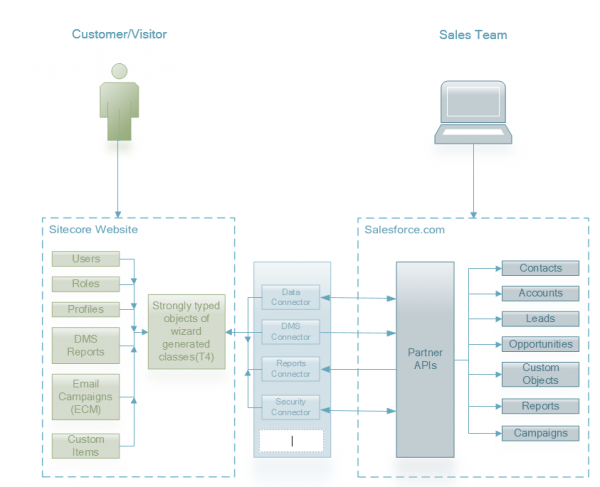Gone are days when going online for an enterprise was considered a proud moment and the only purpose its public facing website served was an instant ‘brochure’ for visitors about its products and offerings. Nowadays visitors can not only browse the information but also can purchase directly on the website or show an interest into particular product or service. Predictive personalization, among many powerful capabilities Sitecore has, is the most notable one as it tracks visitor’s behavior and maps to a predefined pattern which is used then to show relevant content to the visitor.
If your company’s public facing website like ours is powered by Sitecore CMS and a tool of choice for sales folks in your company is Salesforce.com, wouldn’t it be nice to share an intelligence and analytics gathered by Sitecore with Salesforce.com and turn a casual visit into a lead? Wouldn’t it help your sales guy to better understand customers’ behavior and buying patterns? You can essentially drive your Salesforce.com through your public facing website. Similarly showing information stored in Salesforce.com on to Sitecore web site or utilizing it to personalize the content could result into rich experience for web site visitors. Empowering visitors to search documents and information stored in Salesforce.com(SFDC) or view SFDC reports can help your sales people stay focused by not requiring them to manage content through Sitecore CMS.
Enabling information exchange between these two vast systems can truly leverage your company’s investments into Sitecore and Salesforce.com. SFDC objects such as leads, accounts, contacts, opportunities and custom objects are accessible through REST APIs. These APIs are categorized into two: customer APIs and partner APIs. Customer APIs are for a project that is specific to a customer or a situation while partner APIs can be used to develop if a project is meant to be used by several customers. Similarly Sitecore exposes information stored into it such in form of APIs or web services. One may write a custom layer that can bridge two systems. Also a third party connector called S4S(Sitecore for Salesforce) from FuseIT can be used to connect two systems. To the best of my knowledge, it is the only such connector available in the market.
So how does S4S work?
Installing S4S and configuring it for your environment involves lot of manual steps which I am not going to discuss in this blog post. For more details, check out http://www.fuseit.com/Solutions/S4S/. Here is the large picture though: you setup a SFDC user with system admin profile that will be used by connector to access Salesforce.com and you configure Sitecore to use this connection and then SFDC objects can be accessed in Sitecore through creating instance of wizard generated strongly typed classes.
S4S has four different connectors that can be installed:
- Data Connector – Captures data from Sitecore web site and serializes it to SFDC
- DMS Connector – Transfers information in Sitecore’s Analytics Engine to SFDC
-
Reports Connector – Makes it possible to view and search SFDC reports from Sitecore website
-
Security Connector – This is the most interesting one and if you opt to install it, you need to install a SFDC package which adds a section to a SFDC contact where a Sitecore username and password is stored. Other fields are also added to a contact where you can specify a Sitecore landing page, Sitecore user profile and areas of interest. Basically SFDC acts as a data source for a custom Asp.Net role-membership provider for Sitecore CMS. This is particular helpful if your Salesforce.com users want to log in to Sitecore using SFDC credentials. It also enables SFDC users to drive Sitecore CMS directly from SFDC.
<
p style=”text-align: left;”>Appropriate integration between Salesforce.com and Sitecore can result into increases leads and opportunities and more recurring business revenue for your organization. I will write detailed instructions to setup and configure S4S connector in a separate blog post.

